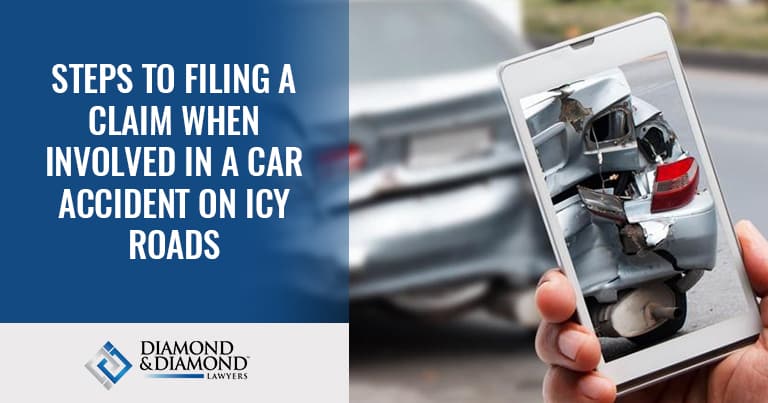Winter weather often results in unsafe driving conditions, leading to an increased risk of an accident. In fact, if you’ve driven on an ice-covered road, you probably know how dangerous it is. You know that your control over your vehicle is at best tenuous and even the slightest change in the road’s surface can cause an accident.
Common dangerous road conditions during winter include icy roads, heavy snowfall, reduced visibility, and road obstructions. As a consequence, it makes driving more difficult and hazardous. This is why you should always exercise adequate safety precautions while driving during the winter.
Fortunately, insurance companies take road conditions into account when filing claims for icy accidents. Here are the steps to filing a successful claim when involved in a car accident on icy roads.
Step 1: Call The Police and Seek Medical Services Immediately After the Car Accident
The first thing to do when involved in a car accident due to an icy road is to check on the safety and well-being of your passengers and the other individuals involved.
If anyone appears to be injured, call the paramedics immediately and seek prompt treatment, especially if the passenger sustains a head injury. Regardless of the apparent injury, call the police and ask them to send an officer to the scene. Having a police report created at the time of the accident is extremely important in ascertaining which driver is legally at fault.
Step 2: Take Photos of The Car Accident Scene and Any Injuries Sustained
There are a number of steps you should take when making an ice or snow car accident compensation claim that can really help to strengthen your case.
For strong pieces of evidence, remember to always take photos or live video of the following:
- Road condition
- Vehicles involved
- The location of traffic signals
- Car positioning
- Tire marks
- Any obvious skid marks, debris, or other evidence.
Doing so may strengthen your case in a car accident and help in determining the amount of compensation you should receive. In addition, you may wish to keep track of the weather and road conditions at the time of the accident. Other supporting documents for your claim include the following:
- Receipts for any expenses you incurred for prescriptions, travel expenses, counseling, and so on.
- A medical report of your injuries, treatment recommendations, and expected recovery time.
Step 3: Obtain Witnesses’ Testimony
 Gathering details and necessary evidence is essential to make a successful car accident claim. Witnesses are often one of the most helpful resources to determine fault when it comes to car accidents, especially if it involves icy roads.
Gathering details and necessary evidence is essential to make a successful car accident claim. Witnesses are often one of the most helpful resources to determine fault when it comes to car accidents, especially if it involves icy roads.
In order to make the most of witnesses’ testimonies as evidence, make sure to get these details:
- The name, address, driver’s license number, vehicle licenses, and insurance information from all other drivers involved.
- The names and contact information of the witnesses.
- Try to get as many details as you can of any bystanders and witnesses.
Furthermore, if there is another vehicle or driver involved, other insurance companies may be going to be looking for someone to throw the blame at. There’s a chance that they will pursue a claim against you. So it’s important to know that you should avoid making any statements to others that could be used against you later.
“It will not seem as difficult to file car accident claims due to icy roads if you utilize our service at Diamond and Diamond Law. You would just need to call us at 1-800-567-HURT, and a personal injury lawyer from our team will handle your case so you can focus on your recovery.”
Step 4: Call Your Insurance Company and Alert Them of the Car Accident
 As soon as possible, you should contact your insurance provider. Your insurance company will assign a claim number and assign an adjuster to handle the claims process on your behalf. That way, your case can start the process immediately.
As soon as possible, you should contact your insurance provider. Your insurance company will assign a claim number and assign an adjuster to handle the claims process on your behalf. That way, your case can start the process immediately.
The insurer will ask you to provide as much information about the accident as possible and may ask you to record your version of events. It is generally advisable to avoid providing a recorded statement. Inform your insurance provider that you will provide all relevant medical information once you have finished treatment for any injuries.
Moreover, you will also want to report the accident is caused by the icy road. It is possible that they will send an individual to analyze the extent of damage to the motor vehicle and determine whether the vehicle can be repaired. In the event that your vehicle is disabled and you do not have a rental car from your own insurance company, ask that a rental car be provided to you.
Consult A Personal Injury Lawyer from Diamond and Diamond Law
When an insurance company determines fault, all circumstances of the accident are reviewed. This includes things like inclement weather or bad road conditions.
However, even if the insurance companies understand that sometimes the weather and road conditions can take control of a vehicle out of the driver’s hands, someone still must carry the responsibility for an accident.
If you have been in a car accident due to an icy road, you don’t want to deal with the stress of dealing with your insurance claim, the experienced personal injury lawyers from Diamond and Diamond can help. We can ease your burden by gathering documentation, gathering facts, and crafting concise and detailed demands for settlement of the claim.
Learn more about what Diamond and Diamond can do for you. Call 1-800-567-HURT today!














